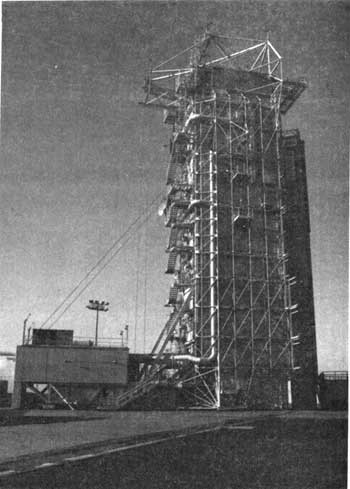.gif)
MENU
|
Man in Space
A National Historic Landmark Theme Study |

|
|
Launch Pads |

Exterior view of Space Launch Complex 2, 1983.
(Courtesy of USAF, Vandenberg AFB, California)
Space Launch Complex 2
| Name: | Space Launch Complex 2 (Missile Launch Complex 2) |
| Location: | Vandenberg Air Force Base, Lompoc, California |
| Owner: | United States Air Force/National Aeronautics and Space Administration |
| Condition: | Excellent, altered, original site |
| Builder/Architect: | U.S. Air Force |
| Dates: | 1957-1984 |
DESCRIPTION
Space Launch Complex 2 (SLC-2) is at Vandenberg Air Force Base and is part of the Kennedy Space Center Western Test Range Operations Office. This complex is composed of the NASA Launch Operations Building, Blockhouse, and two launch pads (East and West). SLC-2E was decommissioned and stripped in 1975, SLC-2W is active. Its last launch is scheduled for March 1984. Only the blockhouse and pad 2-W with supporting structures retain their integrity and are considered a part of this nomination. The NASA Launch Operations Building served to house NASA and contractor personnel between launches and is not considered integral to the site and is not included in this nomination.
Blockhouse
The Launch Control Blockhouse at SLC-2 was and is used to control launches from both the East and West Pads. The blockhouse is a self-contained reinforced concrete building capable of withstanding the dangers of catastrophic vehicle failure at lift-off. The control room houses numerous monitor consoles necessary to support the vehicle and spacecraft during testing and final countdown. Television monitors are mounted in the control room wall for viewing the vehicle and critical prelaunch functions from cameras at vantage points around the complex. [1]
Umbilical Tower
The Umbilical Tower supports purge, coolant, and propellant lines as well as electrical cables and environmental ducts required for checkout and launch of the Delta Space vehicle. The Tower is an 8-feet x 8-feet x 124 feet-high free standing steel structure. [2]
Service Structure
The Service Structure is a rail-mounted, steel structure 166 feet high. The enclosed tower, which is moved by a hydraulic drive system, is used for erection, assembly, and checkout of Delta launch vehicles. The structure has a 15-ton overhead bridge crane, a 3-ton interior bridge crane, and one 2500-lb. capacity elevator. Eight working levels are provided, with the top one infinitely adjustable within an 18-feet working range. [3]
Support System
The support system for SLC-2 includes propellant storage and handling equipment, hydraulic power units, high pressure nitrogen and helium storage tanks, and a nitrogen purge system. An air-conditioning unit, hydro-pneumatic controls, and vehicle checkout equipment are housed in the Launch Pad Building and in the electrical equipment building. The launcher has a wet flame bucket that is used during ignition and lift-off of the Delta Space Vehicle. [4]
STATEMENT OF SIGNIFICANCE
Space Launch Complex 2 was built for the Air Force in 1957 for their Intermediate Range Ballistic Missile (IRBM) Testing Program. The complex fired the Thor IRBM in various USAF testing programs during its early years.
NASA acquired SLC-2E in 1962 and SLC-2W in 1969. Minor modifications were made on both pads so that NASA could launch its Delta rocket. Since the Delta was a direct outgrowth of the Thor rocket, modifications were kept to a minimum. The complex was used by NASA to launch polar orbiting satellites using the reliable Delta rocket. As the need to launch polar orbiting satellites decreased, NASA abandoned SLC-2E in 1975 and concentrated its operations at SLC-2W. SLC-2E reverted to the control of the Air Force which decommissioned and stripped the pad of all of its equipment and salvageable materials in 1975.
SLC-2W is the best surviving example of a launch complex built in the 1950s at the beginning of the American effort to explore space. The blockhouse, with its supporting electrical equipment, is intact. Only the most minimum of modifications were made over the years. The blockhouse with its electronic equipment is today the best surviving example of working electronics used to support a space launch from this era. The only comparable example is the blockhouse at Launch Complex 26 at Cape Canaveral Air Force Station. The equipment at Launch Complex 26 is not operational. It was reconstructed for visitor interpretation when Launch Complex 26 became part of the United States Air Force Museum. The equipment at the blockhouse at SLC-2 is operational, dates from the period of the 1950s, and is integral to the site. It is the best surviving example of this technology.
In a similar manner the Launch Pad at SLC-2W is intact and survives from the 1950s with only minor modifications done to change from the Thor to the Delta Launch Vehicle. While the Redstone gantry at Launch Complex 26 and the Atlas gantry at Launch Complex 13 at Cape Canaveral Air Force Station are comparable, the gantry and supporting structures at SLC-2W are in a better state of preservation. SLC-2W is still a working complex and has been continuously maintained since 1957. The last maintenance performed on Launch Complex 13 was in 1978. The Redstone gantry at Launch Complex 26 is in serious danger of being lost to rust and the elements.
SLC-2W with its blockhouse is a unique resource that represents the best surviving example of a working 1950s-era launch complex that propelled Americans into Space.
FOOTNOTES
1. Western Test Range Operations Handbook (John F. Kennedy Space Center, January 1968), p. V-1.
2. Technical Facilities Catalog Vol. II (Washington, D.C.: National Aeronautics and Space Administration, 1974), p. 9-151.
4. Western Test Range Operations Handbook, p. V-7.
BIBLIOGRAPHY
Technical Facilities Catalog Vol. II. National Aeronautics and Space Administration: Washington, D.C., 1974.
Western Test Range Operations Handbook. John F. Kennedy Space Center: Florida, 1968.
PHOTOGRAPHS
(click on the above photographs for a more detailed view)
 Top
Top
Last Modified: Mon, Jan 8 2001 10:00:00 am PDT
http://www.cr.nps.gov/history/online_books/butowsky4/space13.htm
![]()



